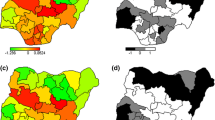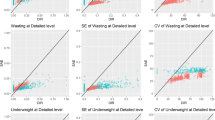Abstract
Issues of malnutrition among young children in developing countries are gaining more attention of policy-makers because of the adverse effects on the well-being of people and economic of these nations. Anthropometric variables used for determining malnutrition are measured through z-scores where those whose measures fall into the extreme ends of the scores are considered malnourished. Conditional mean regression has been adopted to examine the determinants but often times, covariates would have effect on the mean, but have no substantial influence on more extreme quantiles. We adopt Bayesian quantile regression approach to measure the spatial distributions of childhood undernutrition at state and local government levels in Nigeria. Markov random fields and Bayesian P-splines were used as priors for the spatial and nonlinear components respectively and estimation was through MCMC technique. Results show the existence of north-south divide in undernutrition in Nigeria and that observed socioeconomic variables could have little influence on the distribution of undernutrition across space in the country.







Similar content being viewed by others
Notes
Water sources classified as protected are: piped into dwelling/yard, public tap/standpipe, tube well/borehole, protected well, protected spring, rainwater, and bottled water while those classified as unprotected include unprotected well, unprotected spring, tanker truck/cart with drum, surface water, sachet water, and other sources.
Toilet facilities considered as improved are: flush/pour into piped sewer system, flush into septic tank, flush into pit latrine, ventilated improved pit latrine, pit latrine with slab, and composite toilet. Those considered as non-improved include flush not to sewer/septic tank, pit latrine without slab/open pit, bucket toilet, hanging toilet and no facility/bush/field.
References
Adebayo, S. B. (2003). Modelling childhood malnutrition in Zambia: An adaptive Bayesian splines approach. Statistical Methods & Applications, 12, 227–241. https://doi.org/10.1007/s10260-003-0057-z.
Babalola, S., & Fatusi, A. (2009). Determinants of use of maternal health services in Nigeria – Looking beyond individual and household factors. BMC Pregnancy and Childbirth, 9(43). https://doi.org/10.1186/1471-2393-9-43.
Belitz, C., Brezger, A., Klein, N., Kneib, T., Lang, S., & Umlauf, N. (2015). BayesX - Bayesian inference in structured additive regression models. http://www.uni-goettingen.de/de/bayesx/550513.html. Accessed 20 March 2016.
Black, R. E., Brown, K. H., & Becker, S. (1984). Malnutrition is a determining factor in diarrheal duration, but not incidence, among young children in a longitudinal study in rural Bangladesh. The American Journal of Clinical Nutrition, 37, 87–94.
Borooah, V. (2002). The role of maternal literacy in reducing the risk of child malnutrition in India. International Center for Economic Research.
Brezger, A., & Lang, S. (2006). Generalized structured additive regression based on Bayesian P-splines. Computational Statistics and Data Analysis, 50, 967–991.
Eilers, P. H. C., & Marx, B. D. (1996). Flexible smoothing with B-splines and penalties. Statistical Science, 11(2), 89–121. https://doi.org/10.1214/ss/1038425655.
Fahrmeir, L., & Kneib, T. (2011). Bayesian smoothing and regression for longitudinal, spatial and event history data, Vol. 36, Oxford Statistical Science Series. New York: Oxford University Press Inc..
Fahrmeir, L., Kneib, T., & Lang, S. (2004). Penalized structured additive regression for spacetime data: A Bayesian perspective. Statistica Sinica, 14, 731–762.
Fahrmeir, L., & Lang, S. (2001). Bayesian inference for generalized additive mixed models based on Markov random field priors. Journal of the Royal Statistical Society (Series C), 50, 201–220.
Gayawan, E. (2014). A Poisson regression model to examine spatial patterns in antenatal care utilization in Nigeria. Population, Space and Place, 20, 485–497. https://doi.org/10.1002/psp.1775.
Gayawan, E., Adarabioyo, M. I., Okewole, D. M., Fashoto, S. G., & Ukaegbu, J. C. (2016). Geographical variations in infant and child mortality in West Africa: A geo-additive discrete-time survival modelling. Genus, 72(5). https://doi.org/10.1186/s41118-016-0009-8.
Gayawan, E., Arogundade, E. D., & Adebayo, S. B. (2014). Possible determinants and spatial patterns of anaemia among young children in Nigeria: A Bayesian semi-parametric modelling. International Health, 6, 35–45.
Gayawan, E., & Turra, C. M. (2015). Mapping the determinants of child mortality in Nigeria: Estimates from mortality index. African Geographical Review, 34(3), 269–293.
Kandala, N. B., Fahrmeir, L., Klasen, S., & Priebe, J. (2009). Geo-additive models of childhood undernutrition in three sub-Saharan African countries. Population, Space and Place, 15, 461–473. https://doi.org/10.1002/psp.524.
Kandala, N. B., Lang, S., Klasen, S., & Fahrmeir, L. (2001). Semiparametric analysis of the socio-demographic determinants of undernutrition in two African countries. Research in Official Statistics, 4(1), 81–100.
Khatab, K. (2012). Associations between nutritional indicators using geoadditive latent variable models with application to child malnutrition in Nigeria. In A. Rodriguez-Morales (Ed.), Current topics in tropical medicine (pp. 545–546). Croatia: InTech.
Klasen, S. (1996). Nutrition, health and mortality in sub-Saharan Africa: Is there a gender bias? Journal of Development Studies, 32, 913–932.
Koenker, R., & Bassett, G. (1978). Regression quantile. Econometrica, 46, 33–50.
Lang, S., & Brezger, A. (2004). Bayesian P-splines. Journal of Computational and Graphical Statistics, 13, 183–212.
Magalhaes, R. J. S., & Clement, A. C. A. (2011). Mapping the risk of anaemia in preschool-age children: The contribution of malnutrition, malaria, and helminth infections in West Africa. PLoS Medicine, 8(6), e1000438.
Martorell, R., Khan, L. K., & Schroeder, D. G. (1994). Reversibility of stunting: Epidemiological findings in children from developing countries. European Journal of Clinical Nutrition, 48, 45–57.
Pelletier, D. L., Frongillo, E. A., Schroeder, D. G., & Habicht, J. P. (1995). The effects of malnutrition on child mortality in developing countries. Bulletin of the World Health Organization, 73(4), 443–448.
Pongou, R., Ezzati, M., & Salomon, J. A. (2006). Household and community socioeconomic and environmental determinants of child nutritional status in Cameroon. BMC Public Health, 6(98). https://doi.org/10.1186/1471-2458-6-98.
Rice, A. L., Sacco, L., Hyder, A., & Black, R. E. (2000). Malnutrition as an underlying cause of childhood deaths associated with infectious diseases in developing countries. Bulletin of the World Health Organization, 78(10), 1207–1221.
Rue, H., & Held, L. (2005). Gaussian Markov random fields. Theory and applications. Boca Raton: Chapman & Hall/CRC.
Scrimshaw, S., & SanGiovanni, J. P. (1997). Synergism of nutrition, infection, and immunity: An overview. American Journal of Clinical Nutrition, 66(2), 464S–477S.
UNICEF. (2009). Tracking progress on child and maternal nutrition: A survival and development priority. New York: United Nations Children Fund (UNICEF).
UNICEF (2012a). Nigeria launches initiative to save one million lives by 2015. https://www.unicef.org/media/media_66201.html. Accessed 28 Aug 2017.
UNICEF. (2012b). Pneumonia and diarrhoea: Tackling the deadliest diseases for the world’s poorest children. New York: UNICEF.
UNICEF (2016). Nigeria: maternal and child health. http://www.unicef.org/nigeria/children_1926.html. Accessed 5 Oct 2016.
UNICEF, & NBS (2015). Report on the nutrition and health situation of Nigeria, 2015. Abuja, Nigeria: UNICEF & National Bureau of Statistics [Nigeria].
Waldmann, E., Kneib, T., Lang, S., & Yue, Y. (2013). Bayesian semiparametric additive quantile regression. Statistical Modelling, 13, 223–252.
WFP, & UNICEF. (2006). Global framework for action. Geneva: World Food Programme, United Nations & United Nations Children Fund.
WHO Multicentre Growth Reference Study Group. (2006). WHO child growth standards: Length/height-for-age, weight-for-length, weight-for-height and body mass index-for-age: Methods and development. Geneva: World Health Organization.
Yadav, A., Ladusingh, L., & Gayawan, E. (2015). Does a geographical context explain regional variation in child malnutrition in India? Journal of Public Health, 23(5), 277–287. https://doi.org/10.1007/s10389-015-0677-4.
Yu, K., & Moyeed, R. A. (2001). Bayesian quantile regression. Statistics & Probability Letters, 54, 437–447.
Yue, Y., & Rue, H. (2011). Bayesian inference for additive mixed quantile regression models. Computational Statistics and Data Analysis, 55, 84–96.
Acknowledgements
This work was supported with a grant from UNICEF’s Nigeria Country office. We appreciate Measure DHS for granting access to the data and boundary file used for the analysis and useful comments from Elisabeth Waldmann on Bayesian quantile regression.
Author information
Authors and Affiliations
Corresponding author
Rights and permissions
About this article
Cite this article
Gayawan, E., Adebayo, S.B., Komolafe, A.A. et al. Spatial Distribution of Malnutrition among Children Under Five in Nigeria: A Bayesian Quantile Regression Approach. Appl. Spatial Analysis 12, 229–254 (2019). https://doi.org/10.1007/s12061-017-9240-8
Received:
Accepted:
Published:
Issue Date:
DOI: https://doi.org/10.1007/s12061-017-9240-8




